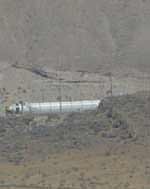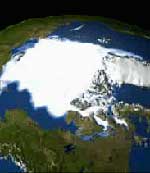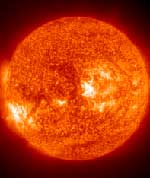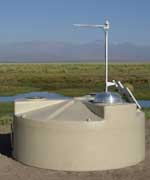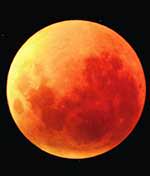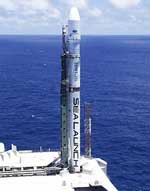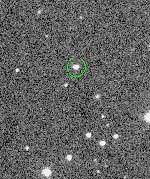
Image credit: Lowell Observatory
Astronomers from the Lowell Observatory have re-discovered a Near Earth Asteroid that hasn’t been seen since 1937. The object is called Hermes and it was originally discovered by German astronomer Karl Reinmuth; a few days later it was out of sight, and astronomers didn’t have enough information about its orbit to locate it again. With the new observations, astronomers believe that Hermes is actually a binary object; it has its own small moon.
The re-discovery of Hermes started early on October 15th by Brian Skiff of the Lowell Observatory Near-Earth-Object Search (LONEOS). Not seen since 1937, asteroid 1937 UB (Hermes) continues to astonish and excite astronomers worldwide. Further observations revealed late yesterday that Hermes is actually two objects–called a binary–circling around one another while about to pass by Earth again.
“This re-sighting of Hermes is the Holy Grail of near-Earth asteroid discovery,” said Edward Bowell, LONEOS Director. “Its orbit has been better calculated and observers have confirmed its re-appearance and also shown its binary nature? well, an asteroid?s return just does not become more profound than this.”
The binary object was some 19 million miles out at the time of re-discovery last Wednesday, nearly 66 years after it was first seen. Hermes, which poses no threat to Earth, will make its closest approach on November 4th. By then it will be 4 million miles away and bright enough for amateurs to see using backyard telescopes.
The same day Skiff captured the first images of Hermes, Discovery Communications, Inc. and Lowell Observatory announced a partnership to build the new Discovery Channel Telescope near Flagstaff, Arizona (http://www.lowell.edu/press_room/releases/recent_releases/dct_rls.html). One research objective for this new $30-million, 4.3-meter telescope will be to significantly accelerate the search for near-Earth objects, including those smaller than Hermes.
First images of the kilometer-size asteroid were captured by a CCD camera during early morning observation through the LONEOS 24-inch Schmidt telescope. More than six decades ago, Hermes was discovered by Karl Reinmuth at Heidelberg, Germany on October 25, 1937. Fast forward to a few days ago when Andrea Boattini of Instituto di Astrofisica Spaziale, Rome, Italy, and Timothy Spahr of the Minor Planet Center in Cambridge, Massachusetts analyzed the new positions of Hermes and determined what it was: the long-lost asteroid.
“Since we find new near-Earth asteroids fairly regularly (I found, for instance, two near-Earth asteroids the same night), my only reaction upon finding it was that it was unusually bright,” Skiff told BBC News Online on Friday.
Up before dawn, Spahr quickly posted Skiff?s discovery on the web, alerting astronomers to follow the asteroid. James Young, at the Jet Propulsion Laboratory?s Table Mountain Observatory in California, was the first to respond, just five hours later. Spahr then located observations made on October 5 by the Near-Earth Asteroid Tracking program (http://neat.jpl.nasa.gov), LONEOS observations from September 28, and unpublished observations made by the MIT Lincoln Laboratory Near Earth Asteroid Research program (http://www.ll.mit.edu/LINEAR), extending the observational arc back to August 26 (http://cfa-www.harvard.edu/mpec/K03/K03T74.html).
At this point, the identification with Hermes was clear from the similarity of the orbits from the 1937 and 2003 sightings, but it was not a simple matter to compute an orbit that linked all the observations together. Steven Chesley and Paul Chodas of the Jet Propulsion Laboratory found that Hermes? trajectory is very chaotic due to frequent close encounters with the Earth and Venus. Following its flyby of the Earth in 1937 at a distance of 460,000 miles (just 1.8 times the Moon?s distance), Hermes made an unobserved close approach to the Earth in 1942 of just 1.6 lunar distance. Using JPL?s Sentry impact monitoring software, Chesley and Chodas were able to find 12 distinct dynamical pathways that produced an encounter in 1937. Picking out the true orbit was then an easy matter, and led to the further prediction that Hermes will not approach the Earth more closely than 8 lunar distances within the next century (http://neo.jpl.nasa.gov/news/news140.html).
On October 16, Andrew Rivkin and Richard Binzel of MIT observed a spectrum of Hermes using the NASA Infrared Telescope Facility in Hawaii, and were able to ascertain that the asteroid is of a type known as S class. Because the surfaces of S-class asteroids reflect, on average, 24% of the sunlight falling on them, Rivkin and Binzel were able to deduce that Hermes is 0.9 km (about 1,000 yards) in diameter.
Over the next few days, the world?s most powerful radar, the 1,000-foot dish, at Arecibo, Puerto Rico, projected radar beams on to the asteroid and captured the faint returning echoes. Jean-Luc Margot, of the University of California, Los Angeles, and his team saw that the asteroid is strongly bifurcated. Two separate components, of roughly equal size and almost in contact, are revolving about their common center of mass in up to 21 hours. It appears that the components have tidally evolved into a situation where their spin period is equal to their orbital period and therefore present the same face to one another all the time, just like the Pluto-Charon system. There are now about 10 radar-observed binary near-Earth asteroids, about 1 in 6 of NEAs larger than 200 m in diameter. “We certainly did not expect to find a binary with roughly equal-sized components,” said Margot. “All the binary NEAs that we have imaged so far show a secondary that is only a fraction of the size of the primary.”
Amateur and professional astronomers are collaborating to observe the way Hermes changes in brightness as its components rotate. Eventually, they should be able to determine the components? orbital plane, an accurate period of revolution, and, perhaps, the shapes of the individual bodies. See http://www.asu.cas.cz/~asteroid/binneas.htm for a list of binary NEAs.
The only near-Earth object not also identified by number, Hermes shares a name in Greek mythology with the son of Zeus, messenger of the gods, god of science, commerce, eloquence, and arts of life. “The name ?Hermes? also means hastener, and representations of him are symbolic of the messenger or the speed and majesty in flight,” according to Schmadel?s Dictionary of Minor Planet Names.
Lowell Observatory was founded in 1894 by Percival Lowell with a mission to pursue the study of astronomy, especially the study of our Solar System and its evolution; to conduct pure research in astronomical phenomena; and to maintain quality public education and outreach programs to bring results of astronomical research to the general public. Visit http://www.lowell.edu; and Friends of Lowell at http://www.lowell.edu/friends/.
LONEOS is one of five programs funded by NASA to search for asteroids and comets that may approach our planet closely. Their current goal is to discover 90% of near-Earth asteroids larger than 1 km in diameter by 2008. There are thought to be about 1,200 such asteroids.
For more information on the discovery and images of Hermes, visit the LONEOS website at http://asteroid.lowell.edu/asteroid/loneos/loneos.html.
Original Source: Lowell Observatory News Release

